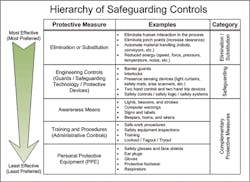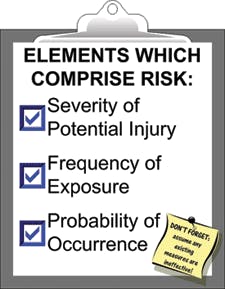Tacitus, the great Roman historian, once said, "The desire for safety stands against every great and noble enterprise." Today I would have to disagree. While he was talking about the need to take risks, in today’s great and noble global enterprises, linked across geographies and at scales and speeds Tacitus couldn’t even imagine, the need is to minimize risk.
Consequently, the desire for safety should stand with every enterprise. It’s a growing imperative.
Safety affects every aspect of the enterprise, from the plant floor to the boardroom. While historically safety has been a local concern, and always will remain so in that a breach of safety takes place at a particular site, approaching safety from a global perspective leads to the application and enforcement of standards and best practices that move safety toward its ultimate goal: making the workplace safe for all employees.
Understanding the value of safety is a key aspect of this perspective. If companies approach safety purely from a cost or regulatory focus (i.e., merely as "an insurance policy"), the positive impact of safety initiatives often falls short of their potential. In fact, a recent survey by Aberdeen, cited on automation.com, underscores this point.
The survey of 169 manufacturing organizations found the biggest difference between best-in-class performers and those below (i.e., average or laggard) was an undue emphasis on cost issues by the latter. Average and laggard performers were more than five times as likely as best-in-class ones to have insurance premiums as the driver behind their safety investments. As the author notes, "It is true that safety technology is a great way to combat rising insurance costs, help reduce adverse events and stay in compliance. But if that is all the technology is being used for, a company is not fully utilizing their safety program."
Top companies realize the ultimate goal of safety is making the workplace safe for their workers, but also that safety, when implemented properly, can improve manufacturing efficiency, protect brand image and protect stakeholder value. These elements, not regulatory compliance alone, justify the enterprise’s investment in safety initiatives and technology.
Methodology and Process
When they consider engaging in safety initiatives with potential service providers, environmental health and safety decision makers should first keep in mind the essential steps involved in implementing the safety process across the global enterprise. Then they should make sure that providers have a thorough understanding of each step.
Identify the machines and processes involved. Identifying applications that require some level of safeguarding typically is the easiest step for individuals responsible for safety, as these applications present themselves in the form of incidents.
Collect the right information. Once a machine or process has been identified for a risk assessment, all the pertinent information related to the application needs to be collected. This data includes machine limitations, lifecycle requirements, energy sources and all available design and system descriptions to establish the nature of the machine or process.
Previous incident history, information regarding damage to health as well as details regarding existing or proposed system or building layouts should be used as pertinent information for the risk assessment. Finally, a list of those who have been or could be exposed to hazards should be compiled, including their level of training, experience, ability and so on.
Get the appropriate people involved. Many jurisdictions require that companies have safety committees, so naturally they should be involved. If a safety committee is not in place, gather input from all personnel who have a vested interest in the safety initiative. Essentially, compile a team that would be a logical safety committee.
Feedback from operators and maintenance personnel is essential for two reasons: One, as they work on and around the machines and processes on a daily basis, they are most likely to ferret out hazards that are not obvious. Two, if the safety initiative is to be successful, these individuals must be onboard with it.
Observe the machines and processes in operation. While many machines are similar in design, end users adapt them to produce specific parts or products based on customer requirements and market demand. Even when machines are identical in design, they can be altered to make a significant difference in the risk level. Therefore, observing them as they are used is imperative.
Pinpoint hazardous areas. Use a task-based approach to create a detailed list of all potential hazardous scenarios. Identify every foreseeable task during the lifecycle of a machine, and then evaluate the potential hazards associated with each task.
Identify the risk level. After the tasks and associated hazards have been determined, assign a risk level to each. There are many prescribed systems to assist in labeling risk levels; whichever system you choose, the assessment team should understand and be comfortable with the processes involved and should know how to properly apply them to risk.
Evaluate the risk level. Evaluating the risk level helps determine if further safeguarding efforts are needed to make the machine or process safe. Risk levels should be tolerable: a reasonable, acceptable level of risk that an individual would normally expect to take when doing work.
Create an appropriate risk reduction system. If each risk initially is not tolerable, apply measures to effectively reduce the risk of the hazard to an acceptable level. Typically this is done hierarchically:
- Hazard elimination or substitution.
- Engineering controls.
- Applying means of awareness.
- Administrative controls.
- Personal protective equipment.
The priority order is based on effectiveness and reliability, with the methods that rely more heavily on human behavior at the bottom of the hierarchy.
Estimate system costs. Accurately identify all costs associated with the final solution.
Provide all required services and materials. Regardless of how the safety initiative is implemented, it is critical that proper materials are selected and installed using proven methods. These methods should meet appropriate global, national, regional and local regulations, as well as applicable consensus standards, user specifications, and manufacturers’ specifications.
Conduct follow-up risk assessments. Follow-up risk assessments must verify that risk levels have been reduced to and maintained at tolerable levels. If not, repeat the process until tolerable risk levels are achieved.
Close out and sign off the process. Before releasing machines and processes to full production capacity, complete the required documentation. Residual risk should be identified and documented. Safeguarding systems should be verified for effectiveness and compliance. When validating installed systems, individuals should not be placed at risk. The end product of the process will be a safe system for personnel and a documented report showing this has been achieved.
The Role of Executive Leadership
Successful safety initiatives need more than a corporate mandate; leadership must come from the highest levels of the organization. This is key for supporting what is a detailed and often laborious process, and particularly for ensuring that safety measures will be employed consistently and in a standard manner across the enterprise.
Financial backing for the initiative is necessary, but so too is the decision-making support that leaders must provide. In any effort as comprehensive as safety, gray areas inevitably will rise. Leadership is needed to resolve conflicts, avoid potential inconsistencies and maintain momentum as the initiative runs its course.
Even with leadership buy-in, safety efforts can meet resistance. Often people think they are safer than they are, and facing the realities of hazards can be challenging when production pressures are high. This is why training, particularly pre-training, is essential.
Not Just Training – Pre-Training
In a recent post on safetycompliancealert.com, the EHS director of a global manufacturer recommends employee education well before the risk assessment process begins. I agree. The best safety initiatives have employees pre-trained before the initiative unfolds, not just after safeguards and procedures are in place.
Pre-training helps employees understand the general concepts of safety: what a risk assessment is and entails, inherent risk in the environment and so on. Participants need to understand the methodology they will be using. In this way, they will realize the importance of their own honest contribution to the process of improving safety. They also will approach their involvement with more realistic expectations.
Habit is a hard thing to break, particularly at the plant level, where repetition is typically at the core of productive work. While information at the most basic level is essential for safety initiatives, organizations are well-served to find sources outside of the plant (unbiased as possible) to weigh the alternatives and find consensus for what needs to be done. Then, with the requisite organizational structure in place, those actions can be enforced. In the end, this strategy will move safety forward effectively.
John Peabody is vice president, Safety Solution Sales, at Omron STI Machine Services Inc.



